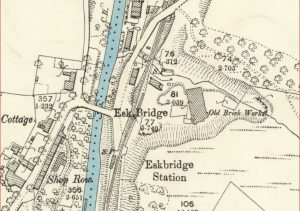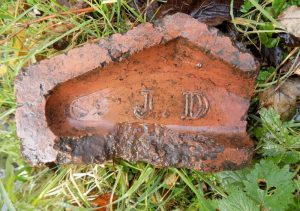Esk Bridge Brickworks, Ellonvale, Penicuik.
1852 – The Esk Bridge Brickworks site was a quarry.
1864 – John Dennis & Co established from headed notepaper but he is described as a bricklayer, furnace builder and contractor – no reference to the brick manufacture at this time.
1878 – John Dennis – Brick or fire clay manufacturer, Bridgend, Lasswade, Edinburghshire.
1878 – John Dennis, Ellonville, Eskbank.
26/04/1879 – Peebleshire Advertiser – On Saturday afternoon while John Tynbee was engaged working a brick making machine at Eskbridge Brickworks his hand was drawn in and so mutilated as to necessitate its amputation, which was satisfactorily performed in the Royal Infirmary, whither he was removed.
1879 – 1880 – John Dennis, brickmaker and furnace builder, Ellonville, Eskbank.
1881 – 1882 – John Dennis, brickmaker, furnace builder, and contractor, Ellonville, Eskbank.
1886 – John Dennis – Brick and tile manufacturer, Ellonville, Esk Bridge, Dalkeith.
Below – 19/03/1890 – Headed notepaper for John Dennis.

Below – 1892 – Esk Bridge Brickworks, Penicuik.

1899 – John Dennis, Brickbuilder, Park Road, Dalkeith.
1901 – John Dennis and Co incorporated into a limited company.
1914 – Furnace and retort builders, chimney stack builders and contractors. Specialities: erecting shale oil retorts, gas retorts, chimney stacks, steam boilers, economisers and other furnaces. Employees 80 to 200
Below – 20/05/1924 – Edinburgh Evening News – Court case regarding the estate of the deceased John Dennis, Brick manufacturer, Dalkeith.

Graces Guide information –
John Dennis and Co of Ellonville, Dalkeith, Midlothian, Scotland
- 1864 Company established.
- 1901 Incorporated as a limited company.
- 1914 Furnace and retort builders, chimney stack builders and contractors. Specialities: erecting shale oil retorts, gas retorts, chimney stacks, steam boilers, economisers and other furnaces. Employees 80 to 200
- Directors: Downie Brown, William Toynbee, Geo. R. Toynbee.
Connection: United Kingdom, Foreign, Colonial. Telephone: No. 75 Dalkeith. Telegraphic Address: ” Dennis, Dalkeith.” Bankers: Commercial Bank of Scotland, Ltd. (Edinburgh and Dalkeith); also Commercial Banking Co. of Sydney, Ltd.
**********************************************
The information below is reproduced by the kind permission of Roger Kelly – click me
The letterhead of John Dennis, Midlothian’s super-efficient bricklayer-contractor in the 1880s and 90s. The company he founded continues to this day. With his younger brother Cammack Dennis’s companion business in Bury, Lancashire, the two contractors specialised in chimneys, retorts, furnaces and boilerhouses, working rapidly with teams of bricklayers hired-in by press adverts from all over the British Isles. The John Dennis letterhead shows some of his best-known work: Y&B (Young & Beilby) retort benches and the elegant stalks of Dennis corniced chimneys. Many of them were to grace the papermills up and down the Esk Valley. The Dennis brothers original surname was Murphy and they came from a chimney-sweeps family at Navenby in Lincolnshire. The 1861 census records Cammack Murphy as a 13-year-old chimney sweep in the village: John Dennis Murphy was already away from Navenby seeking his fortune elsewhere. Tradition has it that John Dennis arrived at Leith in the 1860s with just a bricklayer’s trowel, and the business started from there. John Dennis’s associates in his Scottish enterprise were his site organiser Downie Brown and his Eskbank Penicuik brick and tile works manager John Toynbee, a brother-in-law from Navenby. These Lincolnshire Toynbees were distantly related to the well known historian/journalist family. Alice Toynbee laid the foundation of Penicuik’s Salvation Army Hall. Other Dennis buildings were probably Penicuik Post Office (now Pen y Coe Press), Clippens Oil Co Headquarters (at Straiton Sainsbury Roundabout), Glenkinchie Distillery, as well as miners housing all over the Lothians. John Dennis worked closely with oil and gas engineer and retort designer William Young, the two men were said to have been served dinner on top of a Dennis-built chimney or retort. John Dennis construction teams were active as far afield as France, Australia and Ukraine in the company’s early days.

Bricklayers wanted – For cottage and retort buildings.— Apply Downie Brown, Clippens Pentland Oil Works, Loanhead, by Edinburgh or address John Dennis Dalkeith. –Advertisement in York Herald – Wednesday 25 April 1883 and Manchester Evening News – Thursday 26 April 1883 and Nottingham Evening Post – Thursday 26 April 1883
Bricklayers wanted – Uphall Oil Works, Uphall, near Bathgate, Scotland.—Apply, Downie Brown, Foreman Bricklayer, or John Dennis, Dalkeith. Advertisement in Nottingham Evening Post – Monday 31 March 1884, Lincolnshire Chronicle – Tuesday 1 April 1884 and Friday 4 April 1884 and Friday 11 April 1884; Worcestershire Chronicle Saturday 12 April 1884 and Saturday 19 April 1884 and Saturday 26 April 1884 and Sat 3 May 1884; and Lancaster Gazette Wed 9 Apr 1884
Adapting an earlier structure, John Dennis built himself an elaborate brick-and-stucco mansion in the 1880s. Called Brixwold to acknowledge his Lincolnshire roots, it lies east of Bonnyrigg on the road to Dalhousie Castle. Four stations away from his brickworks at Eskbridge and convenient for the company’s Dalkeith yard, John Dennis lived there with his wife, Rebecca Fieldsend, mother, Sarah Machin, and niece Martha Jane Elliot. John Dennis died in 1912 and his Toynbee relatives inherited the business. Extended with a porch and outbuildings in recent years, Brixwold has been described as an 18th century or even medieval building and sometimes known as Dalhousie Courte.
Below – The well tiled Brickworks Cottage Eskbridge, and characteristic John Dennis upper-access Burnside Cottages across the line. – Pictures Jim Neil.

.








